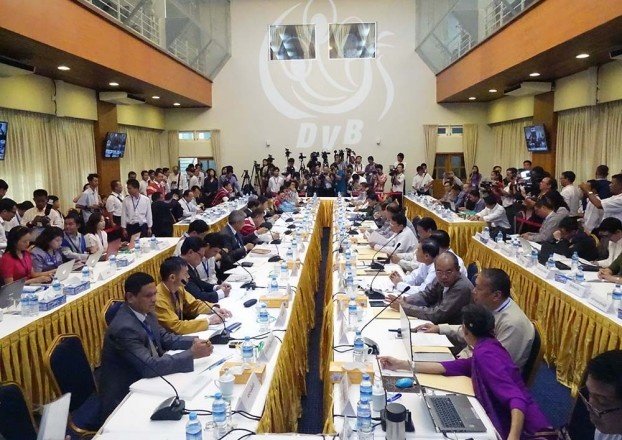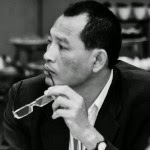Burma: Divisive Ceasefire Won’t Bring Peace
TRANSCEND MEMBERS, 14 Sep 2015
Maung Zarni and Saw Kapi, DVB – TRANSCEND Media Service
8 Sep 2015 – On 9 September the top leaders of the Ethnic Armed Organisations (EAOs) and the three senior most negotiators representing the country’s ethnic alliance of 17 organisations, known as the United Nationalities Federation Council (UNFC), will travel to Naypyidaw to meet with Burmese President Thein Sein and military leaders to press for a genuinely inclusive ceasefire agreement that will have a truly positive impact nationwide.
The EAOs’ insistence that the ceasefire be genuinely inclusive and nationwide is not simply a matter of unrealisable ideals or principles from the perspective of the ethnic communities in conflict zones. Rather it is a very practical issue in that the EAOs have overlapping zones of operations, inter-ethnicity, and linked military ties and crisscrossing cultures. It is therefore inconceivable for any ceasefire agreement that excludes certain key groups to be a genuine step in the direction of lasting peace.
As a matter of fact, irrespective of complex histories and divergent interests, EAOs share a common view that the exclusionary nature of the current NCA offered by the government lacks any real potential for bringing an end to the world’s longest civil war.
This is one of the main reasons that leading opinion makers from Shan, Burmese and Karen communities – including NLD leader Aung San Suu Kyi, Hkun Htun Oo of the Shan National League for Democracy and David Tharkacbaw of the Karen National Union Alliance Affairs, have publicly cautioned against rushing into the signing of the deal – a rush being pushed by Naypyidaw. Why hurry to sign an agreement that has no real prospect of ending the wars that have soaked the country, some 51 million people, in conflict?
The ceasefire efforts are of course welcome news, and the final ceasefire text appears comprehensive, visionary and liberal – incorporating the notions of equality and dignity for all, at least rhetorically.
Why, then, are the Burmese public and specifically the ethnic minorities – who have borne the brunt of the war for over two generations, feeling lukewarm instead of euphoric about an imminent ceasefire?
The short answer is that neither the public at large nor the Senior Delegation of ethnic minority negotiators have appreciable confidence in the government of President Thein Sein as the architect of the ceasefire. The use of security forces on 12 August to remove the President’s inner-party rival, Thura Shwe Mann, from the influential Chair position of the ruling USDP reinforced the now popular view that the Thein Sein government is little more than the military’s civilianised proxy.

Burmese government representatives and ethnic leaders sit for talks at Myanmar Peace Centre in Rangoon in August 2014. (PHOTO: DVB)
But the four year old quasi-civilian government, widely heralded as “reformist” and “pro-peace” unlike any of its military predecessors, is proving to be anything but genuinely reformist, benign or peace-oriented. Far from it, they are proving themselves to be reactionary.
With that said, the final ceasefire text – the outcome of hard-labor throughout nine rounds of negotiations in over 17 months, encapsulates virtually every issue important to minority communities in war zones. Its seven chapters and 33 articles cover a wide range of issues that are crucial for the success of post-conflict nation-building, including monitoring and enforcement of ceasefire agreements, restructuring and reforming the security sector informed by human rights principles, the usual disarmament, demobilisation and reintegration of combatants, the revival of a federal system of government, respect for universal human rights, advancement of gender and ethnic equality, opposition to sexual violence and forced labor, separation of church and state and refrain from racist mobilisation for political gains, rehabilitation of war-impacted communities, humanitarian cooperation, environmental protection, celebration of cultural and linguistic diversity, educational plans, and sustainable development.
The agreement’s guiding principles echo celebrated liberal ideals such as liberty, equality, democracy and self-determination. No wonder then that the core nations that have been funding Burma’s peace process, including the EU, Japan and Norway, see the signing of this accord as historic progress towards peace.
During the last round of negotiations on 6 and 7 August, Burmese government representatives and the Senior Delegation representing the alliance of Ethnic Armed Organisations (EAOs), reportedly agreed on all contentious issues pertaining to the ceasefire except the inclusion of three important armed organisations, namely Myanmar National Democratic Alliance Army (MNDAA), the Ta-ng National Liberation Army (TNLA) and the Arakan Army (AA) and three smaller and un-armed ethnic opposition groups. The government seeks to play up the fact that it accepts 15 out of a total of 21 ethnic organisations, armed and unarmed, for ceasefire agreement signing.
From the perspective of ethnic minorities, the government’s refusal to include these three EAOs runs counter to the spirit – and definition – of a nationwide ceasefire, regardless of the official explanation. After all, these groups much prefer a political solution to their ethnic grievances to the continuation of armed conflicts and continue to make overtures of peace to the government.
To the minorities, the continuing clashes with the excluded groups will allow the active military activity to simmer on, with the potential for spillover into the ceasefire zones. Nai Hongsa, one of the key ethnic minority negotiators and leader of the Mon ethnic group, is quoted in the Burmese-language Irrawaddy magazine that “if these groups are attacked [by the government] we will have to help defend them as they are our military and political allies.”
Besides, it makes no sense for the government to exclude – or delay the inclusion of the Kokang Chinese group known as MNDAA that enjoys widespread nationalist support within the increasingly powerful China. For there is a strong reason to deny the nationalists in China a reason to support an armed ethnically Han Chinese group living along the porous Sino-Burmese borders.
The Arakan Army and Palaung ethnic group’s TNLA armed organisation are seen by the government as the creations of one of the most defiant and best-armed group, namely the Kachin Independence Army (KIA), which previously signed the only written bilateral ceasefire with the military government- a ceasefire which collapsed when Thein Sein came to power in 2011.
The Arakan Army has great potential for troop expansion, given that there are estimated 200,000 Rakhine, mostly men, working in the commercially lucrative Kachin state where the KIA is headquartered and AA is based. Besides, the ethnic Rakhines with their coastal ancestral land in Western Burma have centuries-old historical grievances against the colonizing Burmese rulers from the central plains. So, not pursuing a ceasefire with the AA, which is expanding its operations in the already conflict-ridden Rakhine state, further undermines the government’s credibility in peace making.
This gap between the government’s reformist, pro-peace rhetoric and its coercive and contradictory deeds remains the most formidable barrier to the ceasefire as genuinely nationwide and inclusive enough to put out the fire of ethnic and political grievances among the country’s sizable ethnic minorities, estimated as at least 40 percent of the population.
The government has freed the country’s iconic dissidents, most noticeably the Nobel Peace Prize winner Aung San Suu Kyi, opened up the parliamentary system welcoming Suu Kyi as an MP, relaxed media censorship and normalised historically troubled international relations with the West. However, behind this reform process, the government has consistently resorted to violence, coercion and other heavy-handed approaches characteristic of the previous military dictatorships. A cursory look at the government’s track record of four years in handling land rights activists protesting against the confiscation of farm lands, fiercely independent local journalists, student activist, labor organisers, Buddhist monk protesters against the ecologically disastrous Chinese mega-mines, not to mention its systematic persecution of the Rohingya, effectively shatters the image of Burma’s government as the pursuer of peace and reconciliation.
Even leaving aside the nearly half-century of the painful memories of war crimes and human rights atrocities, the current government’s credibility gap since it assumed state power with the military’s backing four years ago, is a growing barrier to peace. The beautifully worded ceasefire agreement and word of its imminent signing does not trigger nationwide welcome or jubilation.
For the wider public and the ethnic communities in war zones are sticking with what they know: understanding Thein Sein’s reforms and the military’s offer of ‘discipline flourishing democracy’ as window dressings performed so that the military can tango with western business and governments. The nationwide ceasefire sadly may prove to be more such spin to keep the mirage of change alive.
Importantly, one of the authors is from the dominant Burmese majority – from a large military clan whose members include the very first commanding officer to the now semi-retired Snr-Gen Than Shwe and a VIP military pilot for his predecessor, the late despot Gen. Ne Win. The Burmese author can confess how colonial we Burmese typically are in the way we perceive, treat and relate to the rest of the country’s ethnic peoples.
Burma’s leaders, particularly generals past and present, lack both genuine acceptance of multi-ethnic peace on equal terms and an appreciation for the decades of bitter experiences of war-torn communities. Without these two essential pillars, sustainable peace in my country of birth is not conceivable, formal ceasefire or not.
_________________________________
Related Stories:
- Interview: Vijay Nambiar, the UN’s observer to Burma’s peace talks
- President ‘did not discuss’ Myitsone dam in China, says Ye Htut
- Suu Kyi calls for ‘free and fair elections’ as campaign begins
Dr. Maung Zarni, Associate Fellow, the University of Malaya, is a member of the TRANSCEND Network for Peace, Development and Environment, founder and director of the Free Burma Coalition (1995-2004), and a visiting fellow (2011-13) at the Civil Society and Human Security Research Unit, Department of International Development, London School of Economics. His forthcoming book on Burma will be published by Yale University Press. He was educated in the US where he lived and worked for 17 years. Visit his website http://www.maungzarni.net.
Saw Kapi is a Karen educator and an adviser to the Leader of the Senior Delegation negotiating ceasefire agreement with the Burmese government on behalf of the EAOs.
DISCLAIMER: The statements, views and opinions expressed in pieces republished here are solely those of the authors and do not necessarily represent those of TMS. In accordance with title 17 U.S.C. section 107, this material is distributed without profit to those who have expressed a prior interest in receiving the included information for research and educational purposes. TMS has no affiliation whatsoever with the originator of this article nor is TMS endorsed or sponsored by the originator. “GO TO ORIGINAL” links are provided as a convenience to our readers and allow for verification of authenticity. However, as originating pages are often updated by their originating host sites, the versions posted may not match the versions our readers view when clicking the “GO TO ORIGINAL” links. This site contains copyrighted material the use of which has not always been specifically authorized by the copyright owner. We are making such material available in our efforts to advance understanding of environmental, political, human rights, economic, democracy, scientific, and social justice issues, etc. We believe this constitutes a ‘fair use’ of any such copyrighted material as provided for in section 107 of the US Copyright Law. In accordance with Title 17 U.S.C. Section 107, the material on this site is distributed without profit to those who have expressed a prior interest in receiving the included information for research and educational purposes. For more information go to: http://www.law.cornell.edu/uscode/17/107.shtml. If you wish to use copyrighted material from this site for purposes of your own that go beyond ‘fair use’, you must obtain permission from the copyright owner.
